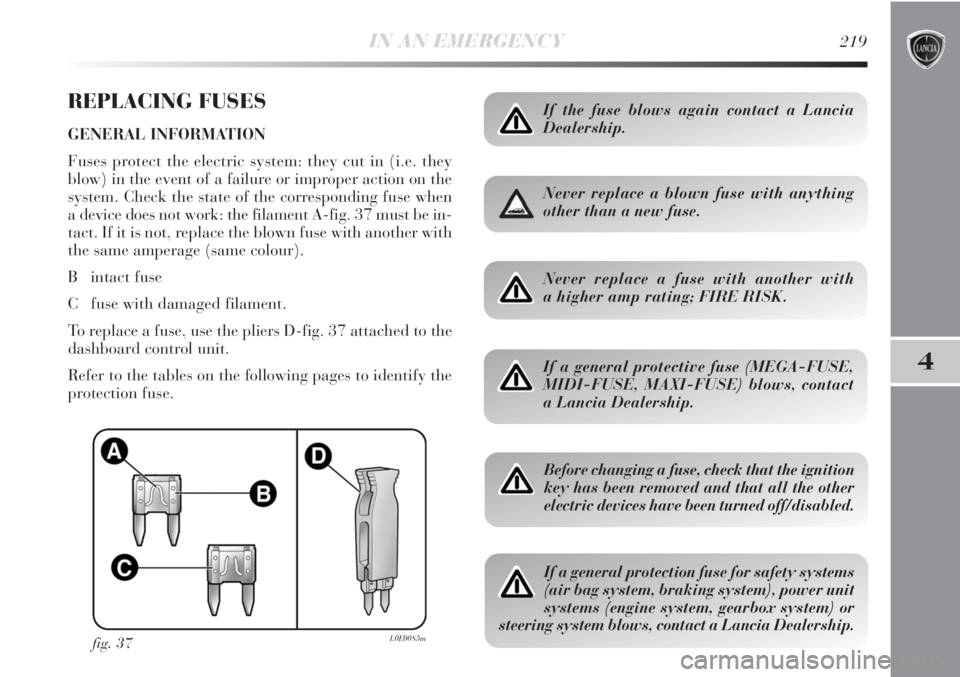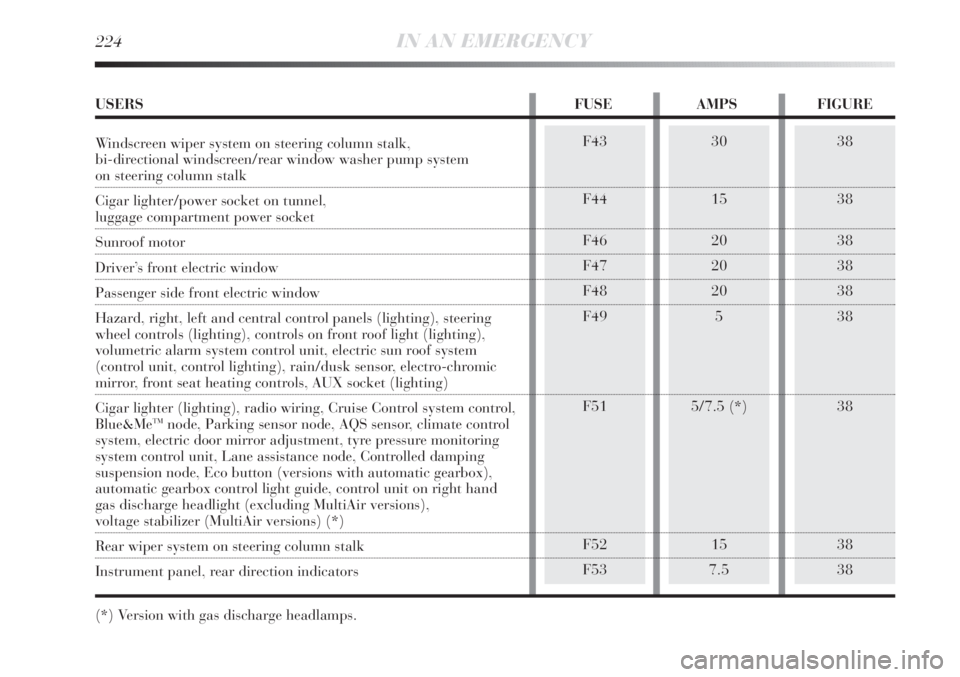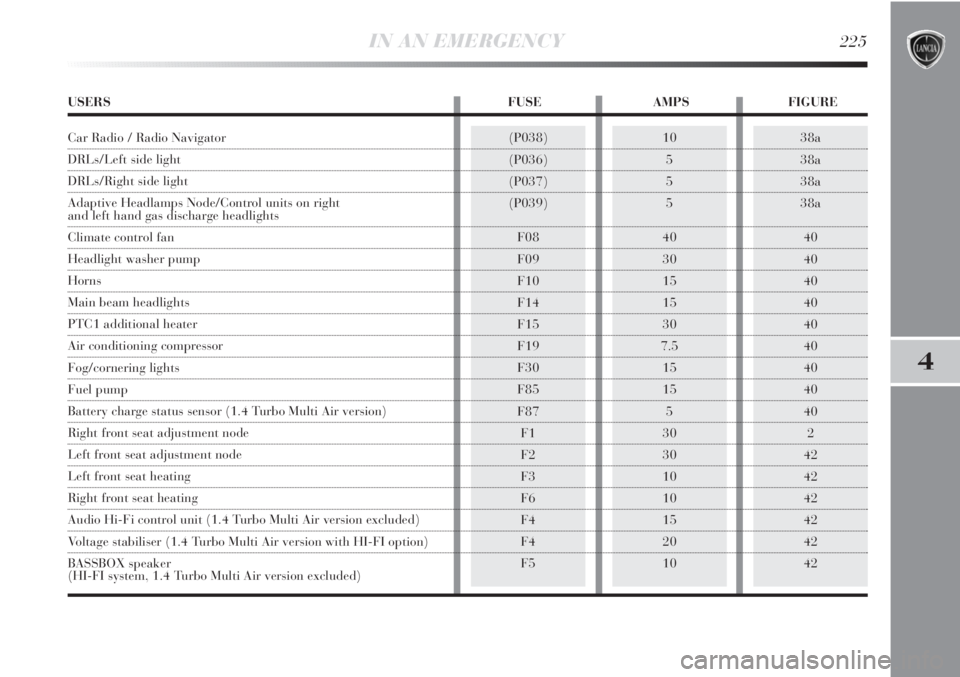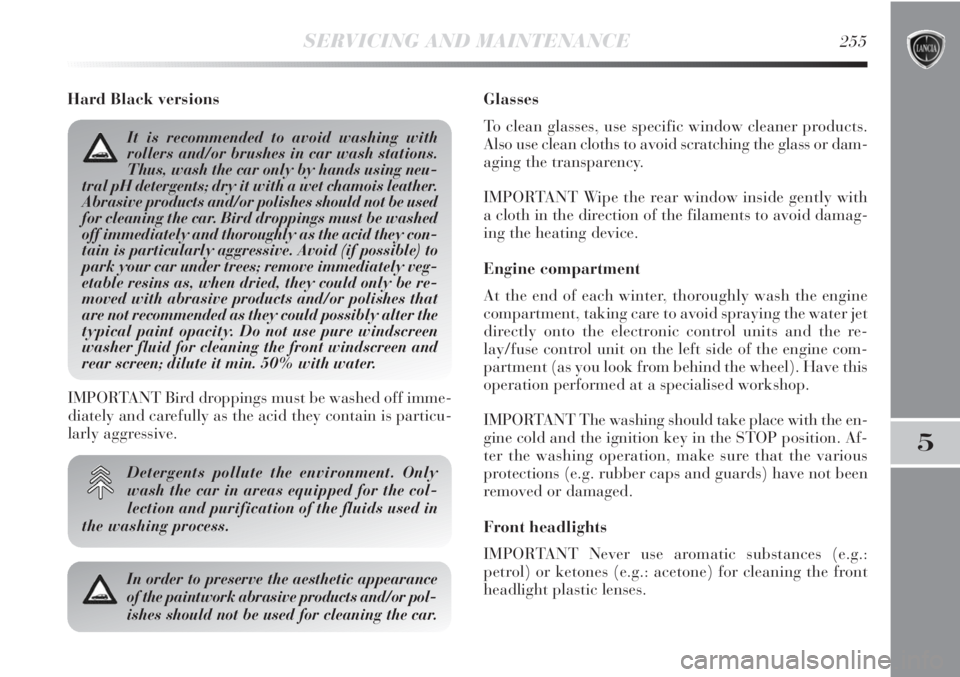fuse Lancia Delta 2012 Owner handbook (in English)
[x] Cancel search | Manufacturer: LANCIA, Model Year: 2012, Model line: Delta, Model: Lancia Delta 2012Pages: 295, PDF Size: 8.29 MB
Page 208 of 295

206IN AN EMERGENCY
After tyre replacement
❍Stow the space saver wheel D-fig. 10 in the space pro-
vided in the luggage compartment;
❍fit the partially open jack in its box forcing it lightly
to prevent it from vibrating when travelling;
❍put the tools back into place in the container;
❍stow the container, complete with tools, in the spare
wheel and tighten the locking device B-fig. 10;
❍reposition the boot mat correctly.
IMPORTANT Do not use inner tubes with tubeless tyres.
Check the inflation pressure of the tyres and the space-
saving wheel periodically.CHANGING A BULB
GENERAL INSTRUCTIONS
❍Before changing a bulb, check the contacts for rust-
ing;
❍burnt-out bulbs must be replaced by others of the
same type and wattage;
❍always check the alignment of the beam after chang-
ing a headlight bulb;
❍when a light is not working, check that the corre-
sponding fuse is intact before changing a bulb. For the
location of fuses, refer to the paragraph “Replacing
fuses” in this chapter.
Modifications or repairs to the electric sys-
tem that are not carried out properly or do
not take the system technical specifications
into account can cause malfunctions leading to the
risk of fire.
Various fastening bolts and space-saver
wheels, specific and differing in structural
characteristics, are used depending on the
wheel rim type (alloy or steel). Fastening bolts for
alloy rims can be identified by the presence of a per-
manent washer and a hollow side on the bolt head.
Therefore, you will need to go to a Lancia Dealer-
ship to get the correct type of fastening bolts and
space saver wheel if you change the type of wheels
fitted (alloy rims instead of steel rims, or vice
versa). Keep the bolts fitted as standard in case of
re-use of the wheels originally mounted on the car.
Page 209 of 295

IN AN EMERGENCY207
4
Halogen bulbs contain gas under pressure;
if they break, glass fragments may be dis-
persed.IMPORTANT The headlight inner surface might be
slightly misted: this should not be considered irregular
rather a natural phenomenon due to low temperature and
the air humidity level. Misting will disappear as soon as
the headlights are turned on. The presence of drops in-
side the headlights indicates infiltration of water. Contact
a Lancia Dealership.
IMPORTANT When the weather is cold or damp or after
heavy rain or after washing, the surface of headlights or
rear lights, may steam up and/or form drops of conden-
sation on the inside. This is a natural phenomenon due
to the difference in temperature and humidity between the
inside and the outside of the glass which does not indicate
a fault and does not compromise the normal operation of
lighting devices. The mist disappears quickly when the
lights are turned on, starting from the centre of the dif-
fuser, extending progressively towards the edges.
When handling halogen bulbs, only touch the
metal part. If the transparent bulb is touched
with the fingers, its lighting intensity is re-
duced and life of the bulb may be compromised. In
the event of accidental contact, wipe the bulb with
a cloth moistened with alcohol and leave it to dry.
Where possible, it is advisable to have bulbs
changed at a Lancia Dealership. Proper op-
eration and orientation of the external lights
are essential for driving safety and complying
with the law.
Page 221 of 295

IN AN EMERGENCY219
4
REPLACING FUSES
GENERAL INFORMATION
Fuses protect the electric system: they cut in (i.e. they
blow) in the event of a failure or improper action on the
system. Check the state of the corresponding fuse when
a device does not work: the filament A-fig. 37 must be in-
tact. If it is not, replace the blown fuse with another with
the same amperage (same colour).
B intact fuse
C fuse with damaged filament.
To replace a fuse, use the pliers D-fig. 37 attached to the
dashboard control unit.
Refer to the tables on the following pages to identify the
protection fuse.
fig. 37L0E0085m
If the fuse blows again contact a Lancia
Dealership.
Never replace a blown fuse with anything
other than a new fuse.
Never replace a fuse with another with
a higher amp rating; FIRE RISK.
If a general protective fuse (MEGA-FUSE,
MIDI-FUSE, MAXI-FUSE) blows, contact
a Lancia Dealership.
Before changing a fuse, check that the ignition
key has been removed and that all the other
electric devices have been turned off/disabled.
If a general protection fuse for safety systems
(air bag system, braking system), power unit
systems (engine system, gearbox system) or
steering system blows, contact a Lancia Dealership.
Page 222 of 295

220IN AN EMERGENCY
fig. 38L0E0209m
FUSE LOCATION
Dashboard fuse box
To access the fuses you must remove the press-fitted cover A. The fuse box shown in fig. 38 is located in the lower
area next to the pedal unit.
Page 223 of 295

IN AN EMERGENCY221
4
Engine compartment fuse box fig. 39 and 40
A second fuse box is located on the right side of the en-
gine compartment, next to the battery. To access this fuse
box release the side tabs and remove cover L. The ID
number of the electrical component corresponding to
each fuse can be found on the back of the cover.
fig. 39L0E0088mfig. 38aL0E0211m
If you need to wash the engine compartment,
take care not to directly hit the engine com-
partment fuse box with the jet of water.
Additional fuses (1.4 Turbo Multi Air versions)
On the 1.4 Turbo Multi Air versions there are four addi-
tional fuses (fig. 38a) next to the dashboard junction unit.
Page 224 of 295

222IN AN EMERGENCY
Luggage compartment fuse box fig. 41 and 42
To gain access to the fuse box located on the left side of
luggage compartment open the relevant inspection lid
fig. 41.
fig. 42L0E0115m
fig. 41L0E0114m
fig. 40L0E0210m
Page 225 of 295

IN AN EMERGENCY223
4
FUSE SUMMARY TABLE
F12
F12
F13
F13
F31
F33
F34
F35
F36
F37
F38
F39
F40
F417.5
15
7.5
15
5
20
20
5
20
7.5
10
10
30
7.538
38
38
38
38
38
38
38
38
38
38
38
38
38
USERS FUSE AMPS FIGURE
Right dipped beam headlight
Right dipped beam headlight (Xenon gas discharge bulb)
Left dipped beam headlight, headlight alignment corrector
Left dipped beam headlight (Xenon gas discharge bulb)
Climate control system fan relay coil, body computer
Left rear window winder
Right rear window winder
Reversing lights, engine compartment junction unit relay coils,
brake light pedal control (normally closed contact),
water in diesel sensor, air flow meter/control on clutch pedal
and brake servo pressure sensor (1.4 Turbo Multi Air versions)
Central locking system control unit, fuel flap,
dead lock, tailgate release
Third brake light, instrument panel, Adaptive Headlights Node
(1.4 Turbo Multi Air versions excluded), control unit on left hand
gas discharge headlight (1.4 Turbo Multi Air versions excluded)
Front roof lights, rear central roof light, driver side and passenger side sun
visor lights, luggage compartment roof light, glove compartment courtesy
light (Platinum trim level with optional sun roof - excluding MultiAir version)
Radio wiring/Radio/Radio Navigator (excluding MultiAir versions),
Blue&Me
TMNode, alarm siren, alarm system on roof light, climate control
unit, tyre pressure monitoring system control unit, diagnosis socket connector,
rear roof lights, voltage stabiliser (MultiAir versions without optional HI-FI)
Heated rear window
Electric door mirror demisters, demisters on windscreen jets
Page 226 of 295

224IN AN EMERGENCY
38
38
38
38
38
38
38
38
38F43
F44
F46
F47
F48
F49
F51
F52
F5330
15
20
20
20
5
5/7.5 (*)
15
7.5
USERS FUSE AMPS FIGURE
Windscreen wiper system on steering column stalk,
bi-directional windscreen/rear window washer pump system
on steering column stalk
Cigar lighter/power socket on tunnel,
luggage compartment power socket
Sunroof motor
Driver’s front electric window
Passenger side front electric window
Hazard, right, left and central control panels (lighting), steering
wheel controls (lighting), controls on front roof light (lighting),
volumetric alarm system control unit, electric sun roof system
(control unit, control lighting), rain/dusk sensor, electro-chromic
mirror, front seat heating controls, AUX socket (lighting)
Cigar lighter (lighting), radio wiring, Cruise Control system control,
Blue&Me
TMnode, Parking sensor node, AQS sensor, climate control
system, electric door mirror adjustment, tyre pressure monitoring
system control unit, Lane assistance node, Controlled damping
suspension node, Eco button (versions with automatic gearbox),
automatic gearbox control light guide, control unit on right hand
gas discharge headlight (excluding MultiAir versions),
voltage stabilizer (MultiAir versions) (*)
Rear wiper system on steering column stalk
Instrument panel, rear direction indicators
(*) Version with gas discharge headlamps.
Page 227 of 295

IN AN EMERGENCY225
4
38a
38a
38a
38a
40
40
40
40
40
40
40
40
40
2
42
42
42
42
42
42(P038)
(P036)
(P037)
(P039)
F08
F09
F10
F14
F15
F19
F30
F85
F87
F1
F2
F3
F6
F4
F4
F510
5
5
5
40
30
15
15
30
7.5
15
15
5
30
30
10
10
15
20
10
USERS FUSE AMPS FIGURE
Car Radio / Radio Navigator
DRLs/Left side light
DRLs/Right side light
Adaptive Headlamps Node/Control units on right
and left hand gas discharge headlights
Climate control fan
Headlight washer pump
Horns
Main beam headlights
PTC1 additional heater
Air conditioning compressor
Fog/cornering lights
Fuel pump
Battery charge status sensor (1.4 Turbo Multi Air version)
Right front seat adjustment node
Left front seat adjustment node
Left front seat heating
Right front seat heating
Audio Hi-Fi control unit (1.4 Turbo Multi Air version excluded)
Voltage stabiliser (1.4 Turbo Multi Air version with HI-FI option)
BASSBOX speaker
(HI-FI system, 1.4 Turbo Multi Air version excluded)
Page 257 of 295

SERVICING AND MAINTENANCE255
5
Hard Black versions
Detergents pollute the environment. Only
wash the car in areas equipped for the col-
lection and purification of the fluids used in
the washing process.
Glasses
To clean glasses, use specific window cleaner products.
Also use clean cloths to avoid scratching the glass or dam-
aging the transparency.
IMPORTANT Wipe the rear window inside gently with
a cloth in the direction of the filaments to avoid damag-
ing the heating device.
Engine compartment
At the end of each winter, thoroughly wash the engine
compartment, taking care to avoid spraying the water jet
directly onto the electronic control units and the re-
lay/fuse control unit on the left side of the engine com-
partment (as you look from behind the wheel). Have this
operation performed at a specialised workshop.
IMPORTANT The washing should take place with the en-
gine cold and the ignition key in the STOP position. Af-
ter the washing operation, make sure that the various
protections (e.g. rubber caps and guards) have not been
removed or damaged.
Front headlights
IMPORTANT Never use aromatic substances (e.g.:
petrol) or ketones (e.g.: acetone) for cleaning the front
headlight plastic lenses.
In order to preserve the aesthetic appearance
of the paintwork abrasive products and/or pol-
ishes should not be used for cleaning the car.
IMPORTANT Bird droppings must be washed off imme-
diately and carefully as the acid they contain is particu-
larly aggressive.
It is recommended to avoid washing with
rollers and/or brushes in car wash stations.
Thus, wash the car only by hands using neu-
tral pH detergents; dry it with a wet chamois leather.
Abrasive products and/or polishes should not be used
for cleaning the car. Bird droppings must be washed
off immediately and thoroughly as the acid they con-
tain is particularly aggressive. Avoid (if possible) to
park your car under trees; remove immediately veg-
etable resins as, when dried, they could only be re-
moved with abrasive products and/or polishes that
are not recommended as they could possibly alter the
typical paint opacity. Do not use pure windscreen
washer fluid for cleaning the front windscreen and
rear screen; dilute it min. 50% with water.